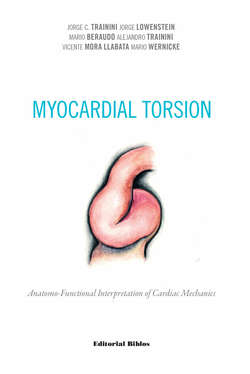Читать книгу Myocardial Torsion - Jorge C. Trainini - Страница 10
3. Segmentation of the myocardial band
ОглавлениеIn its course, the myocardial band adopts a helical configuration that defines the two ventricular chambers. The myocardial band is characterized by a descending and an ascending band. The former includes the right, left and descending segments, while the latter is formed by the remaining ascending segment (Figure 1.4). The figure in 8 outlined by this trajectory defines two loops: a basal and an apical loop. An interesting article by R. F. Shaner in 1923 (84) expresses that the myocardium is formed by “two flattened muscles arranged into a figure of 8. These muscles shorten in opposite directions in systole, emptying the blood content.”
The myocardial band describes two spiral turns with the insertion of its initial end along the line extending from the pulmonary artery to the orifice of the tricuspid valve, called the pulmo-tricuspid cord, in front of the aorta, while its final end attaches below the aortic root. Both ends are fixed by an osseous, chondroid or tendinous nucleus, depending on the different species (animal or human) used in the studies. This nucleus, which has been termed cardiac fulcrum, is the only perceptible edge where the muscle band fibers originate and end, and will be extensively analyzed in this chapter (Figures 1.16 and 1.19).
The basal loop extends from the base of the pulmonary artery to the central band twist. On the other hand, the apical loop courses from this point of inflexion to the base of the aorta. In turn, each loop consists of two segments. The basal loop consists of the right and left segments and the apical loop of the descending and ascending segments (Figure 1.4). In the general loop configuration, the basal loop envelops the apical loop, so that the right ventricular chamber presents as an open slit in the muscle mass thickness forming both ventricles (Figure 1.1). The segments, in turn, are defined by anatomical structures.
Basal loop. The posterior interventricular sulcus presents a trough that establishes the limit between the right and left segments of the basal loop. The right segment constitutes the right ventricular free wall and surrounds the tricuspid valve orifice on the outside. The left segment situated in the left ventricular free wall defines the mitral valve orifice externally. The fibers run from the subepicardium to the subendocardium following a counterclockwise helical direction (apical view of the diaphragmatic surface of the heart in the anatomical position).
Apical loop. The descending apical segment extends from the twist in the band to the apex, where it becomes the ascending segment to end mainly below the base of the aorta in the cardiac fulcrum, a structure to which the myocardial band fibers attach. Both segments mainly form the interventricular septum. Similarly to the basal loop, the fibers run from the subepicardium to the subendocardium, but in this case following a helical clockwise direction (apical view of the diaphragmatic surface of the heart in the anatomical position).
These concepts indicate that the right ventricular free wall is formed by one loop (basal) and the left ventricular free wall by both loops (basal and apical). The fundamental point for cardiac mechanics is that the base and apical muscle fibers course in different directions. This disparity finds correlation with the fiber trajectories and the helical pattern of the muscle band limiting the ventricles.
